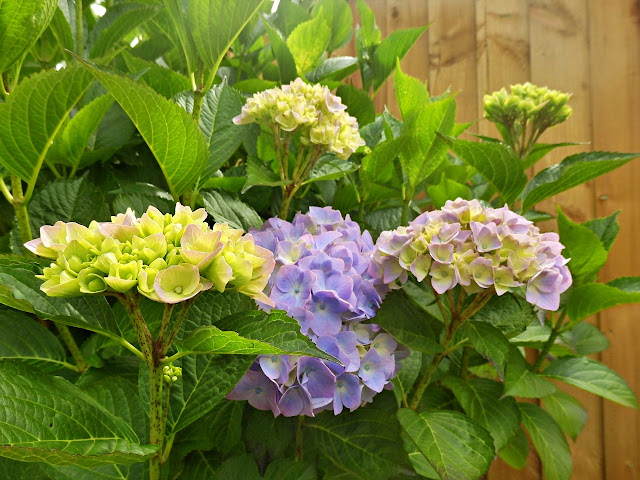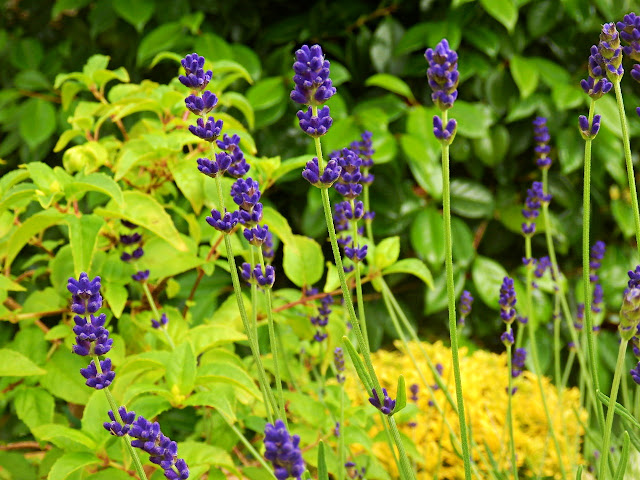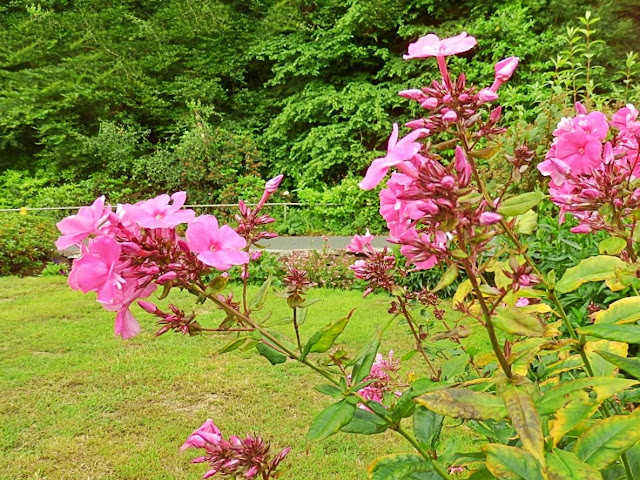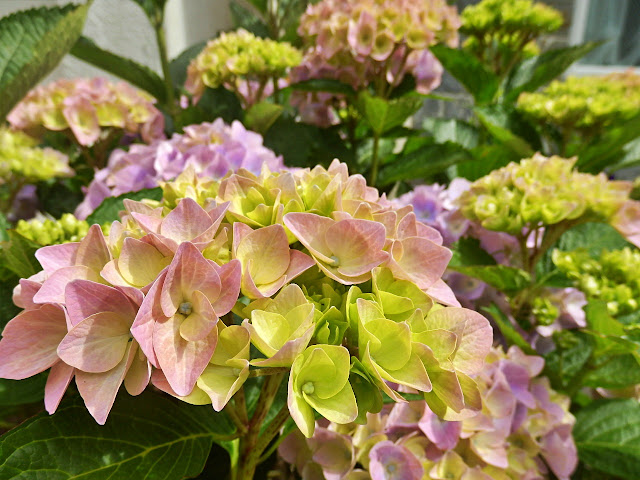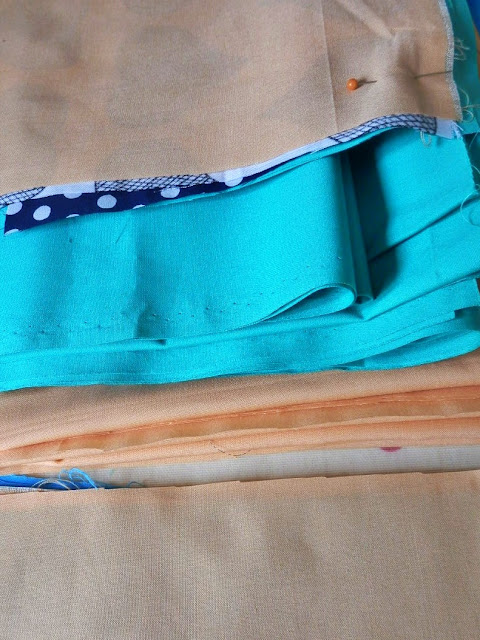Saturday 4 July 2020
The Magical Harbour and Port at Charlestown, Cornwall
Another trip to Charlestown so I have tried to do a different set of photos. In the photo above you can see how the harbour is separated from the port by a gate with a bridge. Below are a couple walking over the bridge, with tall ships in the background.
We were at Charlestown mid morning - but any time is pasty time in Cornwall - as can be seen my the next photo.
There were a few people about ...
… even though it was overcast and quite chilly. The fisherman was quite well layered.
The young don't seem to feel the cold, especially when it's high tide and an opportunity to jump from the harbour wall. It's not really allowed - but it's a fun thing to do.
This girl took the backward route to the water.
There is a magical tunnel. If you dare to walk through you will be awarded with ...
… sunshine and a beautifully coloured sea. You might even fancy a dip!
Returning from the tunnel, the harbour and port can be seen, together with the dividing bridge, previously mentioned. I may visit Charlestown quite often, but never tire of the harbour and tall ships often in dock.
Wednesday 1 July 2020
The Magnificent Coastline Near Gribbin Head, Cornwall
No doubt I have said so previously but I love the Cornish coast near Menabilly and Gribbin Head. Can't fully explain why but it's special to me.
It was a blue sky day so we decided to go for a walk, parking at Menabilly. There is a farmer's field here in which to park - though you have to put 50 pence in an old milk churn for your stay - a bargain at todays rates! The road leading to the field is quite narrow in places.
Near to the field is a track leading past the farmhouse to the coast. It's a fair distance to walk, but we saw a few friendly faces.
And some bales of straw.
On route the Gribbin Tower is often in view. Finally we reached Polridmouth Beach (pronounced Pridmouth). Only a few people about.
From here we walked east to the next small cove which is Daphne du Maurier territory. This is where she once lived and is also the setting for some of her books. Unfortunately what was her home cannot be seen.
The cove has sand and a view of the Gribbin Tower. Mind you, most views seem to feature the Gribbin.
Behind the cove there is an attractive lake belonging to what was once Du Maurier's home. During WW2 lights were fixed around the lake to confuse any enemy aircraft.
Nearby Fowey was a port used for the build up to the D-Day landings. Over 2,000 American troops were based in the area.
By the lake is a cottage featured in Du Maurier's book Rebecca. While we were there the house had workmen busy getting the property decorated. I understand that it is now used to rent out to holiday makers.
From here we headed up to the top of the cliffs via the coastal path - certainly gets the heart pumping!
Once at the top the lovely town of Fowey can be seen and also the village of Polruan.
I decided, however, to have a break from taking photos as I just wanted to enjoy the scenery, good to switch off at times.
So here we are on the return journey showing the coastal footpath towards the Gribbin on the headland.
Such lovely views of the green fields and the sea.
Gribbin Head at its best with the blue sky, greenery, and the red and white of the tower.
And here we are back at Polridmouth Beach, from here it's a walk along the paths to our car. A very pleasant way to spend a few hours
See also
Walking to Gribbin Head Cornwall - Daphne du Maurier Country
The Wonderful Coastline At Menabilly - Daphne du Maurier Country
Monday 29 June 2020
My Cornwall Garden Flowers: 16 Photos
A bit of a wander around our gardens today. Starting off in the back garden, where the lavender has come into flower. It partitions off our table and chairs sitting area. A lovely perfume and lots of interest from the insects.
A climber climbing.
And another brand of lavender.
Fuchsias: always attractive and easy to grow. They are quite happy to stay outside during Cornwall's winters.
Spikey has had some adventures, was in the front garden until some idiot, for want of a better word, threw the plant into the river for some inexplicable reason. But Spikey survived and even flowered - which is unusual. I'm told they only usually flower every ten to twenty years.
Moving on swiftly to the front garden. We are lucky in having trees and a small river on the opposite side of the road.
An abundance of petunias of differing colours.
A neat and tidy fuchsia with lots of flowers.
A young hydrangea and daisies squabbling over who should have the most space.
A few pansies en masse ...
… and a few more self seeded pansies - look at their happy little faces.
Hydrangeas starting to come into pastel shades of colour.
A bit of a gaudy petunia.
And a fuchsia to finish off with.
You may also like:
22 Cornwall Flower Photos
May Flowers In Cornwall
Friday 26 June 2020
St. Piran, Cornwall's Saint, Was Thrown into The Atlantic Chained to a Millstone
A version of the story of Cornwall's St. Piran* from 1865:
Good men are frequently persecuted by those whom they have benefited most. The righteous Piran had by virtue of his sanctity been enabled to feed ten Irish Kings and their armies for ten days together with three cows.
He brought to life by his prayers the dogs which had been killed while hunting the elk and the boar, and even restored to existence many of the warriors who had fallen on the battlefield.
Notwithstanding this and his incomparable goodness, some of the kings condemned him to be cast off a precipice into the sea, with a millstone around his neck.
On a boisterous day a crown of lawless Irish assembled on the brow of a beetling cliff, with Piran in chains. By great labour they had rolled a huge millstone to the top of a hill, and Piran was chained to it.
At a signal from one of the kings, the stone and the saint were rolled to the edge of, and suddenly over the cliff into the Atlantic.
The winds were blowing tempestuously, the heavens were dark with clouds and the waves white with crested foam.
No sooner was Piran and the millstone launched into space, than the sun shone out brightly, casting a full lustre of its beams on the holy man, who sat tranquilly on the descending stone.
The winds died away, and the waves became smooth as a mirror. The moment the millstone touched the water, hundreds converted to Christianity who saw this miracle.
St. Piran floated on safely to Cornwall. He landed on the 5th of March on the sands that bare his name. He lived amongst Cornish men until he attained the age of 206 years.
*The name of the saint is also written as Piran, Peran or Perran
Good men are frequently persecuted by those whom they have benefited most. The righteous Piran had by virtue of his sanctity been enabled to feed ten Irish Kings and their armies for ten days together with three cows.
He brought to life by his prayers the dogs which had been killed while hunting the elk and the boar, and even restored to existence many of the warriors who had fallen on the battlefield.
Notwithstanding this and his incomparable goodness, some of the kings condemned him to be cast off a precipice into the sea, with a millstone around his neck.
At a signal from one of the kings, the stone and the saint were rolled to the edge of, and suddenly over the cliff into the Atlantic.
The winds were blowing tempestuously, the heavens were dark with clouds and the waves white with crested foam.
No sooner was Piran and the millstone launched into space, than the sun shone out brightly, casting a full lustre of its beams on the holy man, who sat tranquilly on the descending stone.
The winds died away, and the waves became smooth as a mirror. The moment the millstone touched the water, hundreds converted to Christianity who saw this miracle.
St. Piran floated on safely to Cornwall. He landed on the 5th of March on the sands that bare his name. He lived amongst Cornish men until he attained the age of 206 years.
*The name of the saint is also written as Piran, Peran or Perran
Tuesday 23 June 2020
The Mystery of the Hidden Stone Tablet at St.Austell Church
 |
| St. Austell Church |
Such busy lives we lead, looking but not seeing. Thousands of people have no doubt walked quickly passed St. Austell Church without noticing the stone tablet in the boundary wall. Okay, it is quite hard to see on the long wall- as the photo below shows.
The stone reads:
Here lyeth the
body of Mary
Harris who died
the 7th June
1734
aged one and
twenty
Here lyeth the
body of Mary
Harris who died
the 7th June
1734
aged one and
twenty
The question is, why did she warrant such a prominent position on the church wall? There are no other such stones. All I know is that she supposedly died of drowning.
I traced her baptism in local records (above) which show she was baptised on the 13th of September 1713 and her father was Nicholas Harris - but her mother's name is left blank on the records.
A sobering thought but I guess very few of us will be remembered in 266 years time.
Saturday 20 June 2020
Walking Gover Valley, Cornwall: Wild Flowers and the Dreaded Japanese Knotweed
A dull rainy day but we wandered along the Gover Valley.
The Gover Stream gurgled along happily as we walked and there were flowers, weeds and herbs for company. They all looked quite healthy because of the recent heavy rain.
We reached some, what I believe to be ovens, left over from the china clay industry which once thrived in Cornwall.
We decided to turn round here and retrace our steps, the stream was still making its merry way to the sea.
Ah, but now we came to some unwanted visitors: Japanese Knotweed! It's the plant to the right of the photo below. Yes, it looks innocent, and later will have nice pink flowers, but it isn't.
To quote the UK Government web site: You could be fined up to £5,000 or be sent to prison for up to 2 years if you allow [Japanese Knotweed] contaminated soil or plant material from any waste you transfer to spread into the wild.
Sadly there is a lot of this knotweed along Gover Valley. It's difficult to eliminate despite the area having been treated.
Moving on we returned home safely!
My wife has been making coronavirus masks. I think she's made over 50 and they have been distributed to relatives, friends and neighbours - whether they want one or not!
Seriously though, masks are now advisable when out and about in crowded places and are compulsory when travelling in buses and trains. Looks like she still has lots more material.
Thanks for the visit, stay healthy.
Subscribe to:
Posts (Atom)
FEATURED POST
A Day in Cornwall: Charlestown, St.Austell, Heligan
A few photos from the last week when we were out and about. Above is the port at Charlestown and below is looking out to sea from the harbo...

























